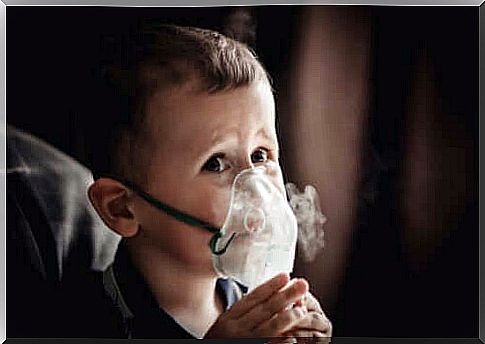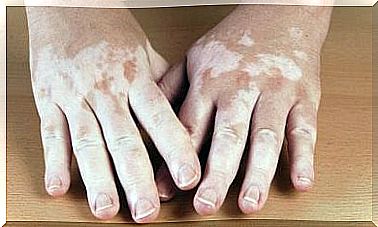Risk, Causes And Symptoms Of Cor Pulmonale

Cor pulmonale is a condition characterized by damage to the right side of the heart as a consequence of severe lung disease. It causes fluid retention and progressive lung failure.
The treatment options are limited as it is necessary to solve the underlying problem. Keep reading to find out more about this interesting condition.
The symptoms
These depend on the severity of the disease and are a product of both the underlying lung disease and the associated heart damage. Therefore, it is common in those with respiratory problems (dyspnoea) with progressive onset.
Basically, this can happen during physical activity with moderate intensity, such as walking long distances or climbing stairs. It can even happen while resting in severe cases.
When heart damage begins, there is swelling due to fluid accumulation (edema) in various parts of the body, such as the lower limbs. Overfilling of the jugular veins, located in the neck, and enlargement of the liver (hepatomegaly) are also common signs.
The main causes of cor pulmonale
This condition is caused by a wide variety of diseases that affect lung function. This includes both vascular system disorders and bronchopulmonary tissue.

Chronic obstructive pulmonary disease (COPD)
As the name suggests, this condition involves progressive lung damage as a result of constant inflammatory reactions. According to the World Health Organization (WHO), it is one of the leading causes of mortality worldwide. The most important risk factors for the development are also long-term smoking and exposure to biomass combustion. The latter occurs when cooking with wood.
The main symptoms of COPD are dyspnoea, productive cough and a tendency to respiratory infections. Lung damage results in reduced oxygenation of the blood and may require permanent oxygen therapy.
There are several associated comorbidities, and cor pulmonale is one of them. This worsens the prognosis as treatment of both conditions is difficult.
Cystic fibrosis
This is a disease with a strong genetic component which, despite being able to affect several systems, finds it most relevant in the lung area. Its characteristic main areas are secretions, especially in the mucus that is naturally produced in the respiratory tract.
As you can imagine, this increases the incidence of fatal respiratory infections, such as those produced by Pseudomonas aeruginosa . The damage is usually so obvious that cystic fibrosis is most often diagnosed in the first months or years of life.
As the disease progresses, it is common for pulmonary hypertension to develop and lead to heart failure. It is also a common index of mortality in children diagnosed with cor pulmonale, according to studies.
Scleroderma
This term describes a group of disorders that cause fibrosis and progressive failure in almost any organ. Fibrosis is a repair process that generates tissue without a specific function.
Dermatological reactions are the most common despite the fact that the lung is one of the most affected internal organs. It results in diffuse interstitial lung disease and also leads to pulmonary hypertension, as in the previous case.
From an epidemiological point of view, scleroderma usually affects women between the ages of 30 and 50. There is no definitive cure, and treatment aims to relieve the symptoms and reduce the associated inflammatory phenomena.
Diagnosis of cor pulmonale
Physicians use a combination of clinical and paraclinical elements to make a diagnosis. Heart damage in the cor pulmonale affects a cavity, right ventricle, and anatomy refers to them as hypertrophy and enlargement.
The former implies an increase in the thickness of the cavity walls, while the latter refers to an increase in the size of the ventricle.
These can be suspected using a simple X-ray of the chest and an electrocardiogram. It is then confirmed by echocardiography or by magnetic resonance imaging.
Pulmonary hypertension that occurs initially is confirmed by catheterization of the right heart. This technique consists of inserting a thin tube between a vein in either the groin, neck or arm. The technician tilts it to reach the right side of the heart to measure the pressure.
Available treatments

Treatment is complicated in most patients, which explains the associated high mortality. Since cor pulmonale is secondary to another condition, the most effective approach involves eliminating or reducing the factors that cause heart damage. This may be impossible in severe cases and may require a lung transplant.
Depending on the patient’s clinical context, there are medications to relieve symptoms associated with fluid retention. Diuretics are useful although there are some contraindications that the attending physician must consider.
There are many medications to treat pulmonary hypertension (such as pulmonary vasodilators). These are usually not effective against diseases that generate cor pulmonale as a complication.
Prevention of cor pulmonale
It is enough to avoid the risk factors for lung pathologies to prevent this condition. Some effective habits are:
- Stop smoking gradually
- Do not cook with wood
- Avoid occupational exposure to toxic substances such as silica, asbestos and beryllium
Cor pulmonale is a serious condition that requires prompt medical evaluation. Contact a specialist as soon as possible if any of the symptoms mentioned above are present. Cardiologists are the professionals you need to seek for this purpose.









